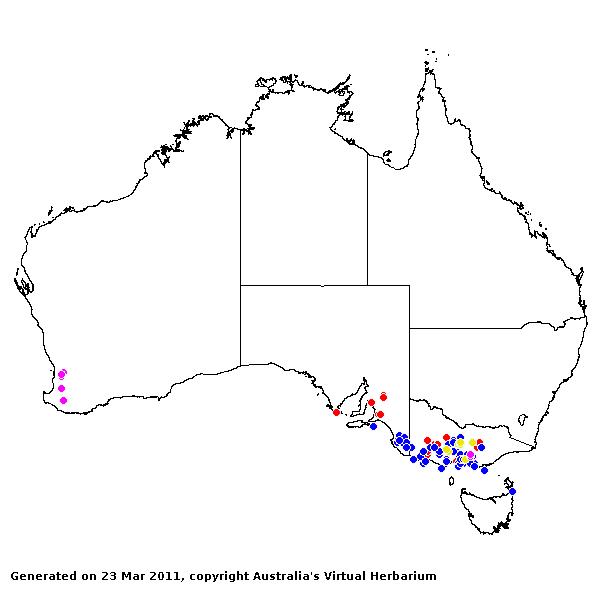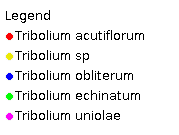Tribolium* Opusc. 64 (1831).
Derivation:. From the Latin tria (three) and bolus (a fiery meteor in the form of an arrow), possibly referring to three florets encased in the very bristly glumes.
Taxonomic revisions, nomenclatural references:. H.P.Linder and G.Davidse, Bot. Jahrb. Syst. 119: 445–507 (1997).
Key references (keys and floras):. J.P.Jessop, Flora of South Australia 4: 1896 (1986) as Plagiochloa; B.K.Simon, Key to Australian Grasses 170 (1993); N.G.Walsh, Flora Victoria 2: 521–522 (1994); D.Sharp and B.K.Simon, AusGrass (2002); K.Mallet (ed.), Flora of Australia 44B: Poaceae 3: 35–38 (2005); J.P.Jessop, Grasses of South Australia 314–316 (2006).
W.D.Clayton & S.A.Renvoize, Genera Graminum (1986), genus (255).
Naturalised. 10 species, from South Africa. 4 species in Australia, WA, SA, NSW, and Vic.
Habit. Annual or perennial, rhizomatous or stoloniferous or tufted. Leaf blades narrow. Ligule a fringed membrane to a fringe of hairs.
Inflorescence. Inflorescence a single spike or a single raceme or paniculate. Spikelet-bearing axes with heteromorphic spikelets or with homomorphic spikelets.
Spikelets. Spikelets laterally compressed or subterete, solitary, long pedicelled; with naked rachilla extension. Fertile spikelets broadly cuneate or sub-orbicular, laterally compressed or subterete, falling with glumes (and with the whole inflorescence, the adjacent node and its leaf) or disarticulating above glumes.
Glumes. Glumes unequal to more or less equal, shorter than spikelet to exceeding florets, shorter than adjacent lemmas or long relative to adjacent lemmas, hairy (with glandular, often tubercle-based hairs) or hairless, glabrous or scabrous, pointed (acute, acuminate or subulate-caudate), awned or awnless, keeled or non-keeled, similar (naviculate, membranous to chartaceous). Lower glume (3–)5(–7) nerved. Upper glume 5(–7) nerved.
Florets. Fertile florets 2–9(–14). Lemmas less firm than glumes to similar in texture to glumes (membranous to chartaceous), entire at apex, pointed to blunt, muticous to mucronate or awned (in Urochlaena, tapering into the awn), without a germination flap, 5–9 nerved, with nerves confluent towards tip, 1 keeled (usually) or not keeled (sometimes). Awns apical, non-geniculate, recurving, much shorter than body of lemma to much longer than body of lemma (but shorter than the glume awns). Palea relatively long, apically notched, thinner than lemma to textured like lemma, 2 nerved, 2 keeled. Palea keels winged or wingless, scabrous or hairy. Distal incomplete florets underdeveloped. Callus absent or short (glabrous). Lodicules 2. Stamens 3. Grain small (1–2 mm long), yellow-brown, obovate, compressed dorsiventrally. Hilum short. Embryo large or small.
Kranz Anatomy. C3.
2n = 12, 2–6 ploid, commonly adventive.
Habitat. Mesophytic to xerophytic. Species of open habitats.
Classification. Danthonioideae.
Notes. Tribolium is clearly a member of the danthonioid grasses. Molecular analyses suggest a sister-group relationship to Karroochloa, Schismus and Rytidosperma, a position corroborated by morphological analysis (Linder & Davidse, 1997).
Types Species. T. hispidum (Thunb.) Desv.
Biogeographic Element. Clifford & Simon 1981, Simon & Jacobs 1990: Naturalised.


